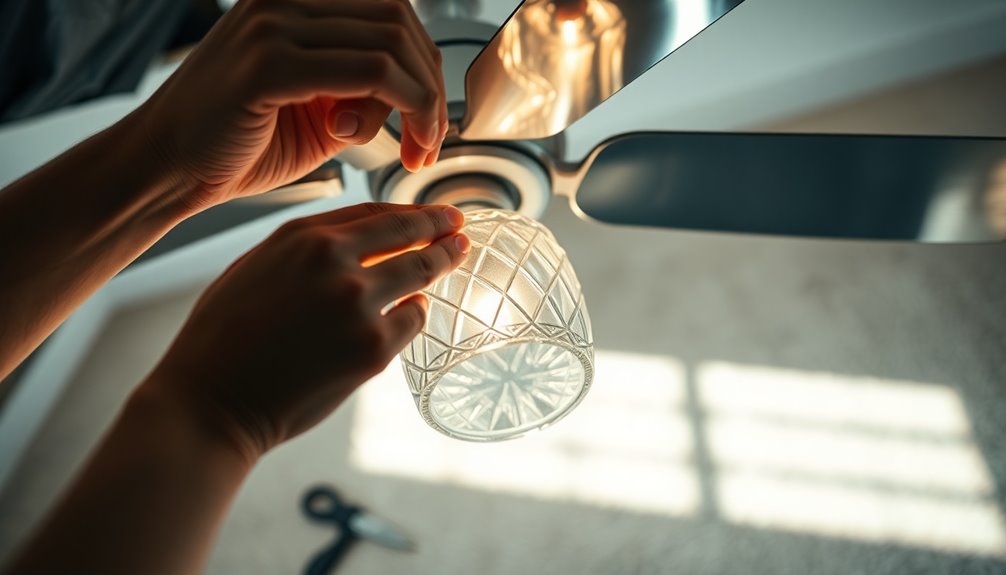The reverse switch on your ceiling fan lets you change the blade direction for maximum comfort all year. In summer, you'll want the fan spinning counterclockwise to create a cooling downdraft, making your space feel cooler without lowering the temperature. When winter comes, switch it to clockwise, which helps circulate warm air down from the ceiling, boosting heating efficiency. This simple adjustment can save you up to 15% on energy costs! Regularly changing the direction as seasons shift is key to maintaining comfort in your home. If you're curious about more tips for using your fan effectively, there's plenty more to explore!
Key Takeaways
- The reverse switch changes the ceiling fan's blade direction for improved comfort in different seasons.
- Counterclockwise rotation in summer creates a cooling downdraft, enhancing the wind-chill effect.
- Clockwise rotation in winter circulates warm air, increasing heating efficiency and comfort.
- Regular adjustments can lead to energy savings of up to 15% on heating and cooling costs.
- Proper use of the reverse switch prevents hot or cold spots and reduces HVAC system strain.
Purpose of the Reverse Switch

The reverse switch on a ceiling fan is an essential feature that allows you to easily adjust the direction of the blades for maximum comfort throughout the year. By changing the ceiling fan direction, you can create ideal airflow tailored to the seasons.
In the summer, setting the fan to rotate counterclockwise generates a cooling downdraft, which enhances your air conditioning's effectiveness and provides that invigorating wind-chill effect you crave.
When winter rolls around, you can flip the reverse switch to make the fan rotate clockwise at low speed. This pulls cool air upward, helping circulate the warm air that tends to gather near the ceiling down along the walls. This simple adjustment not only boosts comfort but also improves heating efficiency.
Plus, utilizing the reverse switch can lead to energy savings of up to 15% on heating costs during colder months, reducing reliance on your heating system.
Generally located on the fan's motor housing, the reverse switch can be a toggle or slide mechanism, clearly indicating the season's settings for ideal airflow.
Summer Fan Operation

During summer, you should set your ceiling fan to rotate counterclockwise to maximize cooling efficiency.
This direction not only creates an invigorating downdraft but also enhances the wind-chill effect, making your space feel cooler.
Utilizing this simple adjustment can lead to a more comfortable environment while potentially lowering your air conditioning costs.
Counterclockwise Rotation Benefits
When you set your ceiling fan to rotate counterclockwise in the summer, you create an invigorating downdraft that enhances comfort in your living space. This counterclockwise motion generates a wind-chill effect, making the air feel cooler against your skin. As a result, you can comfortably raise your thermostat settings, which means less reliance on air conditioning and a more relaxed environment.
By using your fan in this way, you can achieve significant energy savings—up to 15% on cooling costs during warmer months. This is especially beneficial because it reduces the workload on your HVAC system, allowing it to function more efficiently.
When you pair the counterclockwise ceiling fan operation with air conditioning, you create a harmonious cooling environment that maximizes comfort while minimizing energy use.
Remember to adjust your fan to rotate counterclockwise during Daylight Savings Time to signal the shift to warmer weather. By doing so, you not only enhance your comfort but also contribute to lower energy bills.
Enhancing Cooling Efficiency
To maximize your comfort and cooling efficiency in summer, setting your ceiling fan to rotate counterclockwise is crucial. This reverse function enables the ceiling fan blades to create a cooling downdraft, pushing cool air directly downwards.
When you change the direction of your fan, you not only enhance your comfort but also make your environment feel cooler without relying heavily on air conditioning.
By using your ceiling fan effectively, you can greatly reduce air conditioning usage by up to 20%. This means you'll save money on your monthly energy bills, allowing you to enjoy a comfortable space without breaking the bank.
Additionally, make sure your fan is installed at least 7 feet above the floor for ideal airflow and performance.
If you have a larger room, consider using fans with larger blade spans, as they're more effective at moving air efficiently.
Wind-Chill Effect Explained
Understanding the wind-chill effect is key to maximizing your comfort during the summer months. When your ceiling fan spins counterclockwise, it pushes cool air downward, creating a breeze that makes you feel cooler, even if the actual room temperature stays the same.
This wind-chill effect is especially helpful during hot weather, allowing you to enjoy a revitalizing environment without cranking up the air conditioning.
By using your ceiling fan in conjunction with air conditioning, you can create a more pleasant atmosphere while potentially reducing your energy bills. You can set your air conditioning to a higher temperature, thanks to the enhanced cooling provided by the fan. This combination can lead to energy savings of up to 15%.
To maximize the wind-chill effect, aim for a medium or high fan speed. This guarantees effective airflow while minimizing noise, allowing you to relax comfortably.
Winter Fan Operation

Winter brings a unique opportunity to enhance your home's heating efficiency with your ceiling fan. By using the reverse switch, you can adjust the blades to rotate clockwise at a low speed, helping to circulate warm air that's accumulated near the ceiling.
This simple adjustment can greatly improve your comfort while reducing energy costs.
Here are four benefits of using your ceiling fan in winter:
- Enhanced Comfort: The clockwise rotation pushes warm air down along the walls, creating a cozy environment without a chilling downdraft.
- Reduced Heating Costs: Utilizing the reverse function can lower your heating system's runtime, potentially decreasing energy costs by up to 15%.
- Effective for High Ceilings: If you have high ceilings, the reverse function eliminates warm air stratification, ensuring even heating throughout the space.
- Easy Adjustment: It's best to switch to clockwise rotation as temperatures drop, ideally aligning with seasonal changes like Daylight Savings Time. Additionally, using ceiling fans in conjunction with other energy-efficient systems can further enhance property value through modern, efficient systems.
Adjusting Fan Direction
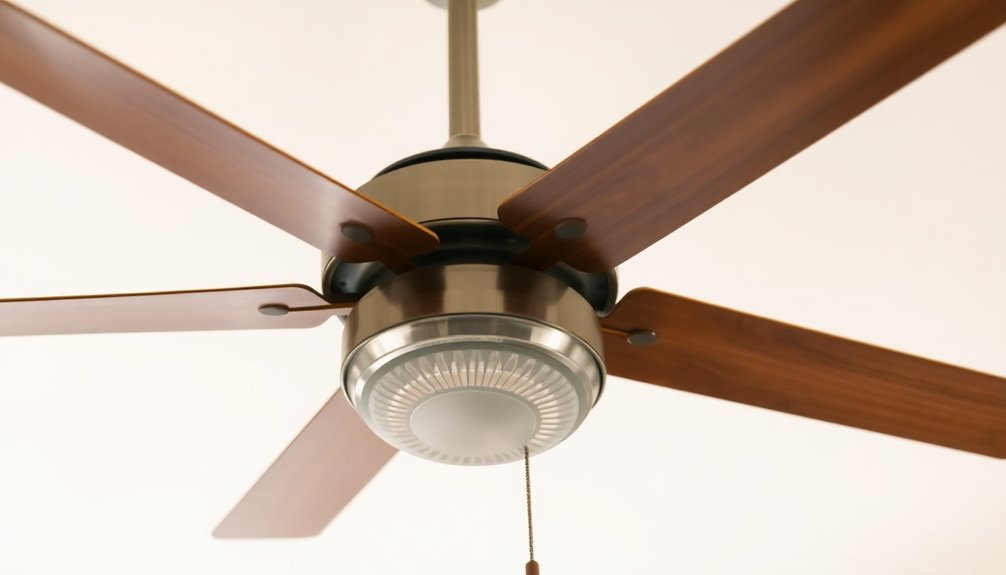
Adjusting your ceiling fan's direction is essential for maximizing comfort throughout the year.
In summer, you'll want it to spin counterclockwise for a revitalizing breeze, while in winter, a clockwise rotation helps circulate warm air.
Whether you use a remote control or a manual switch, changing the fan direction regularly can greatly improve your energy efficiency.
Seasonal Direction Changes
Changing your ceiling fan's direction can greatly boost your comfort throughout the year. By using the fan switch, you can reverse the direction of your ceiling fans to suit seasonal needs.
In summer, set your fan to rotate counterclockwise to create a rejuvenating downdraft, while in winter, switch it clockwise to circulate warm air that's risen to the ceiling. This simple adjustment can improve energy efficiency, reducing heating costs by up to 15% in winter.
To optimize your comfort, consider these seasonal direction changes:
- Spring: Change your ceiling fan to counterclockwise to maximize cooling.
- Fall: Reverse the direction to clockwise to guarantee warm air circulation.
- Daylight Savings Time: Use the clock change as a reminder to adjust your fan.
- Safety: If needed, use a ladder to access the fan switch safely.
Manual vs. Remote Control
When it comes to reversing your ceiling fan's direction, the method you choose—manual or remote control—can greatly impact your experience.
If you have a manual ceiling fan, you'll typically find a reverse switch on the motor housing. This switch lets you adjust the fan direction by toggling it up or down, or left and right, depending on its design.
Just remember to turn off the fan before making this adjustment to avoid any mechanical issues or potential injuries.
On the other hand, remote-controlled ceiling fans offer a more convenient way to change the fan direction. With a simple press of a button, you can reverse the fan's direction without needing to reach up and manually toggle a switch.
Most remote controls even indicate a successful change with a blinking light, giving you instant feedback on the new setting.
Understanding whether your ceiling fan is manual or remote-controlled is essential for effective operation.
The methods for adjusting the fan direction differ considerably, so knowing your fan type will help you make the most of its functionality.
Importance of Proper Rotation
Getting the rotation right on your ceiling fan is essential for maximizing comfort and energy efficiency throughout the year.
By using the fan reverse feature, you can easily change the direction of your fan to suit seasonal needs. Here's why proper rotation matters:
- Cooling in Summer: Set your fan to rotate counterclockwise to create a cooling downdraft. This enhances comfort and can reduce air conditioning costs.
- Heating in Winter: Switch the fan to rotate clockwise at a low speed. This helps circulate warm air that accumulates near the ceiling, potentially lowering heating costs by up to 15%.
- Improved Thermal Comfort: Regularly adjusting the fan direction prevents hot or cold spots in your room, ensuring a more consistent temperature.
- Energy Efficiency: Failing to change the direction seasonally forces your HVAC system to work harder, increasing energy consumption.
Benefits of Reversing Fans
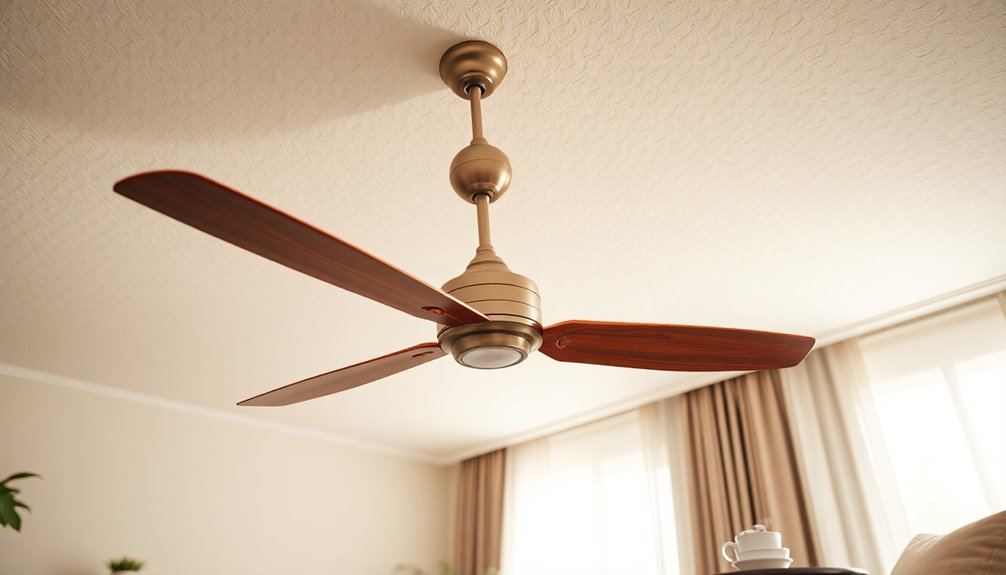
One of the key benefits of reversing ceiling fans is the enhanced comfort it brings to your home throughout the year. When you use the reverse switch on your ceiling fan during winter, it creates an updraft that pushes warm air down, improving thermal comfort and can reduce heating costs by up to 15%.
In summer, setting your fan to counterclockwise generates a cooling downdraft, increasing air circulation and making your space feel cooler, which can decrease your reliance on air conditioning.
By regularly adjusting the fan direction with the seasons, you can optimize the efficiency of your heating and cooling systems, leading to overall energy savings. This smart use of the reverse switch allows you to maintain a comfortable indoor environment while minimizing temperature fluctuations.
With effective air circulation year-round, you not only enhance comfort but also contribute to a more energy-efficient living space. So, when you flip that reverse switch, you're not just changing the direction of your ceiling fan; you're also making a significant impact on your home's climate and your energy bills.
Alternative Options for Non-Reversible Fans
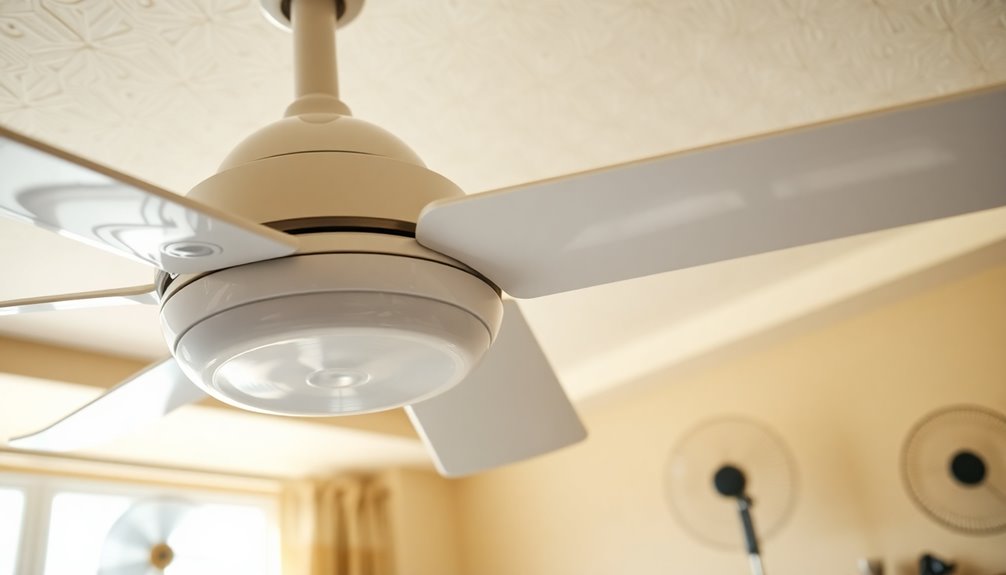
Reversing airflow in ceiling fans offers significant advantages, but what if you own a non-reversible model?
While these fans can't change direction, you can still optimize their performance. Here are some alternative options to weigh:
- Adjust Blade Pitch: A right blade pitch pushes air down, enhancing cooling, while a left pitch pulls air up, ideal for warmer months.
- Upgrade to a Reversible Fan Model: Investing in a reversible fan can greatly improve your airflow efficiency and comfort throughout the year.
- Choose Remote Control Capabilities: When selecting a new fan, look for models with remote controls. This feature allows for easy operation and direction adjustments.
- Regular Maintenance: Keep your non-reversible fan clean and well-maintained. Regular dusting and cleaning can help maximize airflow efficiency, even if you can't reverse it.
Maintenance and Tips for Ceiling Fans
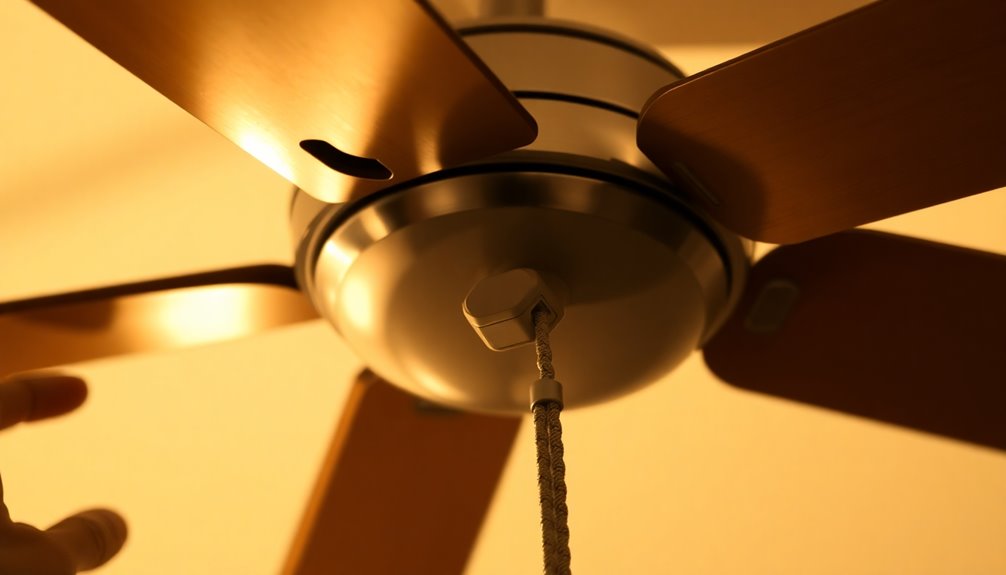
To keep your ceiling fan running efficiently and looking great, regular maintenance is key. Start by dusting the blades and wiping down the motor housing. This simple cleaning can greatly improve airflow efficiency and prolong the life of your fan. Use a soft cloth and a gentle cleaning solution to avoid damaging its finish.
Next, check and tighten all screws and connections periodically. This prevents wobbling and guarantees safe operation, allowing your ceiling fan to turn smoothly.
It's also important to verify your fan is installed at a minimum height of 2.20 meters (7 feet) above the floor for peak performance.
Don't forget about seasonal adjustments! When it's time to reverse your ceiling fan, you can easily change the direction of airflow. In the summer, set it to turn counterclockwise, creating a breeze that helps keep you cool.
In the winter, reverse your ceiling fan to push warm air down, helping you stay warm and cozy. Additionally, using a ceiling fan can enhance airflow while reducing reliance on air conditioning. By following these maintenance tips, you'll enjoy a well-functioning ceiling fan that contributes to your home's comfort all year round.
Frequently Asked Questions
What Is the Purpose of Reverse on a Ceiling Fan?
The purpose of the reverse on a ceiling fan is to change the direction of the blades, allowing you to adapt to seasonal needs.
In summer, you can set it to spin counterclockwise for a cooling breeze, making your space more comfortable.
During winter, switching it to clockwise helps circulate warm air, improving heating efficiency.
Using this feature not only enhances your comfort but can also save you money on energy bills throughout the year.
Should the Direction Switch on a Ceiling Fan Go up or Down?
When it comes to ceiling fans, the direction switch's decision is essential.
For summer's soothing breeze, you'll want the switch down, letting the blades spin counterclockwise to create a cooling draft.
In winter's warmth, flip that switch up for an upward flow, pushing cozy air downwards.
Why Is There a Reverse Switch on a Ceiling Fan?
The reverse switch on a ceiling fan's there to help you adjust air circulation based on the season.
When you flip it, you can change the fan's direction, allowing it to either push warm air down in winter or create a cooling breeze in summer.
This simple adjustment can improve your comfort and might even lower your energy bills.
Understanding how to use this switch guarantees you get the most out of your fan year-round.
What Does the Reverse Button on a Fan Do?
When you press the reverse button on a fan, it changes the direction of the blades' rotation.
This lets you adjust airflow for different seasons. In summer, you can set it to create a cooling breeze, enhancing comfort.
In winter, reversing the direction helps circulate warm air that rises to the ceiling, making your space feel cozier.
It's a simple way to improve energy efficiency and maintain comfort year-round.
Conclusion
To sum up, the reverse switch on your ceiling fan is a fantastic feature for fluctuating seasons. By simply switching directions, you can enjoy a revitalizing breeze in summer and a warm, cozy feel in winter. This versatility not only boosts your comfort but also promotes energy efficiency. So, don't hesitate—flip that switch and feel the fantastic difference. Remember, a little adjustment can lead to a lot of comfort, making your home a haven year-round!




